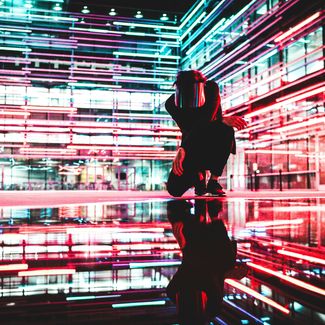
Back From The Future: space Ferrero Rochers, robots and digital rain
The future is already here, but the benefits of it aren’t evenly distributed reckons St Luke's CSO as he reviews SXSW
26 March 2024
The St Luke’s team are back from the future. Well, back from SXSW, which is the closest we can get without a DeLorean tricked out with a flux capacitor. We’ve shaken hands with robots, interacted with holograms and felt the sensation of digital rain fall on our skin. We’ve even eaten what can only be described as ‘space Ferrero Rocher’. It’s another world.
Only, it’s not. The overwhelming sense we got from this year’s SXSW was that the mind-blowing, world-changing tech isn’t 5 or 10 years away, it has arrived. Kids are using AI to do their homework. The robot we met is working in a Paris hospital. Spatial computing, or ‘face computers’ (Apple might cringe at the term) is in the shops. Remarkable advances are being made in clean energy. The Turing test, most experts agree, has been passed. Science fiction is becoming science fact faster and faster. If there’s one word we seemed to hear in almost every talk, it was ‘exponential’. However dramatic the advances in tech we’re experiencing seem, we should expect much more, much faster. Taking AI as an example, over the next few years we should expect large language models to get not just better, but hundreds of times better than they are now.
William Gibson, father of cyberpunk, said: “The future is already here – it’s just not very evenly distributed." As I listened to talks on various topics, I’m tempted to add: the future is already here, but the benefits of it aren’t evenly distributed. The future hand landed, but some folk are getting all the goodies while the rest are left scrabbling for crumbs.
We heard about changes to the wonder drug Ozempic which will make it easier to lose weight, without the injections currently required. But the people who will need it most can’t afford it, while Hollywood uses it to shed the pounds for the red carpet. We heard about geothermal energy tech – a brilliant source of the energy we may need to power AI, also proven to have caused an earthquake that left over a thousand people homeless. We learned of the hidden mental health cost of AI: thousands of low-paid workers spending their days sifting through traumatising imagery to train models so our digital worlds can be kept squeaky clean.
More generally, SXSW painted a picture of a widening gulf between the people whose lives are lifted by the tech ‘super cycle’ and the ones on the side-lines. Experts predict the arrival of the world’s first one-person, billion dollar company - some brilliant entrepreneur, super-charged by AI. It’s not hard to see the flip side, as people with now-defunct skills struggle to adapt or find work. Even now the big tech companies report growing income and shrinking headcounts.
As I travelled home, I listened to Richard Osman and Marina Hyde’s excellent podcast, ‘The rest is entertainment’, where they talked about the gulf between the TV that the media get excited about and what people actually watch. It was a healthy reminder that while we had computers strapped to our heads in Austin, back home Britain was on the sofa watching ‘Death in Paradise’, blissfully unaware. The gulf between the two worlds could hardly feel starker.
So where does that leave us, as we go back to our day jobs at the agency? In an interesting, maybe even unique, place. Advertising is an industry that sits between these two worlds. We are naturally curious and packed with early-adopters, playing with AI, AR and data. But we’re also experts on understanding what makes the mainstream tick. We’re in the break of Corrie, we’re at the bus stop, we’re on the radio as they drive back from Aldi. The panel I moderated at SXSW discussed exactly this - exploring the ways that tech is transforming format-driven creativity, and the underlying truth that what matters to the audience is human stories.
Obviously we don’t have all the answers, and the disruption that is underway will shake up our industry just as much as everyone else’s. But it does make me think there’s an important role to play. We’re the bridge-builders, the translators, who can help make this future a little more evenly distributed. We can take the promise of AI, and the risks, and bring it to life in more human terms than the tech bros we saw in Austin ever could. We can help people understand the changes, so they can navigate this brave new world, and take part in the conversation about how it should be regulated.
Back to time travel: twenty years ago, St Luke’s created an ad for BT that explained the potential of the internet in a way that Britain had never seen before. It looked beyond hyperlinks and download speeds to show the possibilities that would open up in everyone’s lives. It’s the ad that made me want to join the agency, and still one of my favourites. And it’s exactly the kind of creativity society is going to need if we want everyone to be part of what’s coming next.
Dan Hulse is CSO at St Luke’s






